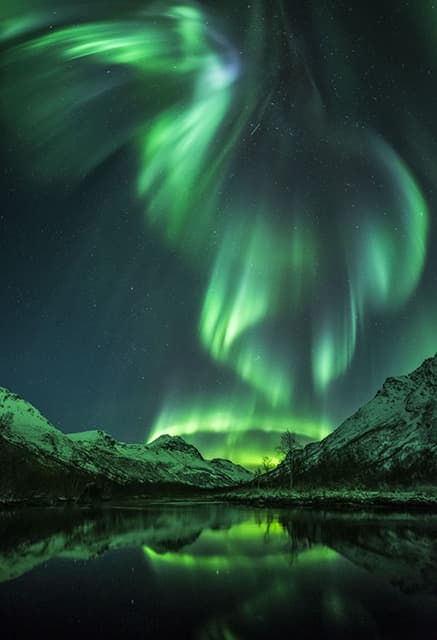Seven Magic Points © Rune Engebø (Norway) The rusty red swirls of the circular, iron sculpture Seven Magic Points in Brattebergan, Norway, mirror the rippling aurora above
The contest, now in its eighth year, pulled in more outstanding entries from amateurs and professionals than ever before, say organisers.
This year’s shortlisted images include shots of Venus and the Moon overlooking the International Space Station, and new stars born in the pink clouds of the Lagoon Nebula, 5,000 light years away.
Among the entries running for title glory is a view of the Perseid Meteor Shower shooting across the sky and appearing to cascade from Mount Shasta in California, USA.
Organisers said: ‘The range of locations is not just limited to our planet.
‘Photographers have also captured sights from across our Solar System, galaxy and the wider universe; from the tempestuous storms visible across the face of our Solar System’s largest planet, Jupiter, looming in the night sky; to the luminous tangle of filaments of Pickering’s Triangle – one of the main visual elements of a supernova remnant in the Veil Nebula, whose source exploded around 8,000 years ago.’
 Northern Lights over Jökulsárlón, Iceland © Giles Rocholl (UK) A couple takes in the awe-inspiring sight of the Northern Lights streaking across the night sky over the lagoon at Jökulsárlón, Iceland on Valentine’s night. 2016
Northern Lights over Jökulsárlón, Iceland © Giles Rocholl (UK) A couple takes in the awe-inspiring sight of the Northern Lights streaking across the night sky over the lagoon at Jökulsárlón, Iceland on Valentine’s night. 2016
The winners will be announced on 15 September at the Royal Observatory in Greenwich, London.
The £10,000 top prize – four times the 2015 figure – may have tempted more photographers to enter this year.
Awards include a £750 prize for the best photo by an amateur astrophotographer who has taken up the hobby in the past year and who has not entered the competition previously.
Judges include Turner Prize-winning photographer Wolfgang Tillmans, who has a passion for astronomy.
Category winners each stand to pocket £1,500.
If you like what you see here, the best entries are due to go on show in a free exhibition at the Royal Observatory Greenwich, London SE10 8XJ from 17 September.
See astronaut Tim Peake’s best photos from space here
 Alone © Lee Cook (UK) With temperatures close to -15 degrees, it’s not surprising that the photographer was the only soul in the vicinity of Plateau Hut in Mount Cook National Park, New Zealand. The lonely hut, dwarfed by the snowy mountains of the park, contrasts with the abundance of star trails seemingly encircling the Anzac Peaks
Alone © Lee Cook (UK) With temperatures close to -15 degrees, it’s not surprising that the photographer was the only soul in the vicinity of Plateau Hut in Mount Cook National Park, New Zealand. The lonely hut, dwarfed by the snowy mountains of the park, contrasts with the abundance of star trails seemingly encircling the Anzac Peaks
 Aurora Bird © Jan R Olsen (Norway) The vivid green Northern Lights resemble a bird soaring over open water in Olderdalen, Norway
Aurora Bird © Jan R Olsen (Norway) The vivid green Northern Lights resemble a bird soaring over open water in Olderdalen, Norway
 Parallel Mountains © Sean Goebel (USA) The shadow of Mauna Kea, the highest peak in the state of Hawaii, is projected by the rising sun over the volcano, Hualalai, whilst the Full Moon soars above them, higher again
Parallel Mountains © Sean Goebel (USA) The shadow of Mauna Kea, the highest peak in the state of Hawaii, is projected by the rising sun over the volcano, Hualalai, whilst the Full Moon soars above them, higher again
The contest featured the following categories:
• Skyscapes: Landscape and cityscape images of twilight and the night sky featuring the Milky Way, star trails, meteor showers, comets, conjunctions, constellation rises, halos and noctilucent clouds alongside elements of earthly scenery
• Aurorae: Photographs featuring auroral activity
• People and Space: Photographs of the night sky including people or a human interest element
• Our Sun: Solar images including solar eclipses and transits
• Our Moon: Lunar images including lunar eclipses and occultation of planets
• Planets, Comets and Asteroids: Everything else in our solar system, including planets and their satellites, comets, asteroids and other forms of zodiacal debris
• Stars and Nebulae: Deep space objects within the Milky Way galaxy, including stars, star clusters, supernova remnants, nebulae and other intergalactic phenomena
• Galaxies: Deep space objects beyond the Milky Way galaxy, including galaxies, galaxy clusters, and stellar associations
• Young Astronomy Photographer of the Year: Pictures taken by budding astronomers under the age of 16 years old








